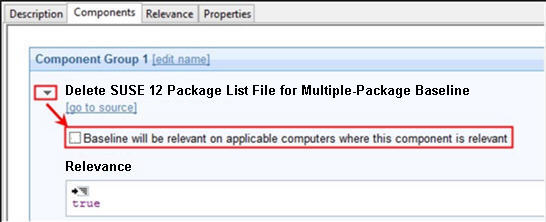Installing multiple packages in a baseline
The multiple-package baseline installation feature helps you to save time when deploying Fixlets with multiple unique packages from a baseline.
Before you begin
- As older versions of zypper cannot resolve dependency conflict issues, ensure that you patch
zypper with the latest update. By doing so, you can ensure that Fixlets for SUSE Linux Enterprise
release packages, such as
sled-release-12-5.1.x86_64.rpmorsles-release-12-5.1.x86_64.rpm, can be installed successfully in the baseline. For details about how to search for certain Fixlets with the zypper patch update, see Creating a search filter for zypper patches. - Set the client download precache size to at least 2GB. Use the _BESClient_Download_PreCacheStageDiskLimitMB setting to set the suggested size for the precache.
- Set the client download cache size to at least 2GB. Use the _BESClient_Download_DownloadsCacheLimitMB setting to set the suggested size for the cache.
- Ensure that you have at least 4GB of free disk space on each endpoint.
About this task
To run a single zypper call to install or update packages for all Fixlets in the baseline, you must add the task to enable the feature and add the appropriate multiple-package baseline installation task into the baseline. For a list of the available tasks, see Multiple-Package Baseline Installation.
Notes:
- Packages with broken dependencies are skipped whenever possible. Packages with dependency issues
with a SUSE product, such as SLED-12-0.x86_64, cannot be skipped. Another scenario where packages
are not skipped is when dependency errors occur during installation, as indicated by the following
error message:
File conflicts happen when two packages attempt to install files with the same name but different contents. In such cases, the installation is canceled and no patches will be installed on the endpoints. - The multiple-package baseline installation feature does not support the pre-cache option Start download before all constraints are met in Take Action.
Important: The Enable the Multiple-Package Baseline Installation
feature and Multiple-Package Baseline Installation tasks must be
added in the same baseline in order for this feature to work. Also, the order of the tasks and
Fixlets are crucial to the baseline installation, therefore take careful note of the steps as they
must be taken in the correct order.
Procedure
-
Create a baseline.
Highlight the Fixlets from a Fixlet site and select Add to New Baseline from the context menu. You can also select Create New Baseline from the Tools menu.
- Optional:
Add the Delete SUSE 15 Package List File for Multiple-Package Baseline
Installation task or add the Delete SUSE 12 Package List File for
Multiple-Package Baseline Installation or the Delete SUSE 11
Package List File for Multiple-Package Baseline Installation task before
adding any of the
Fixlets.
Ensure that the Baseline will be relevant on applicable computers where this component is relevant option is not selected.
Figure 1. Baseline component option 
-
Add the appropriate Enable the Multiple-Package Baseline Installation
feature task.
Ensure that the Baseline will be relevant on applicable computers where this component is relevant option is not selected.
-
Selectively add the patch Fixlets in the baseline.
Ensure that for all Fixlets the Baseline will be relevant on applicable computers where this component is relevant option is selected.Note: If you add two or more Fixlets to the baseline that affect different versions of the same package, the installation task will skip the older versions of the package and install the latest one only.
-
Add the appropriate Multiple-Package Baseline Installation task at the
end of the baseline. With this task, you can deploy any of the following actions:
- Run a preview of the installation, without actually installing the packages, to check for possible issues.
- Install all the RPMs in a single zypper transaction.
Ensure that the Baseline will be relevant on applicable computers where this component is relevant option is not selected.
What to do next
- The repositories that are registered on the endpoint must contain the target packages and all the required dependency packages.
- Allow enough time for a Fixlet, which is using the multiple-package installation method, to complete all zypper transactions and refresh the status on the endpoints before individually deploying the same Fixlet.
- Do not run multiple baselines from the same site on the same endpoint.
- Follow the Baseline Best Practices documented in the following site: https://support.hcl-software.com/csm?id=kb_article&sys_id=d288c2021b098c9477761fc58d4bcbdf
Note: When you deploy the baseline, the initial sub-action status for all the patch Fixlets
will show that they failed. This is the expected behavior. The process for downloading and
installing the packages in the baseline is not done at the Fixlet action level, but in the
Multiple-Package Baseline Installation task. When the baseline completes, the
baseline sub-action status of the Fixlets will reflect the final state of each patch
installation.